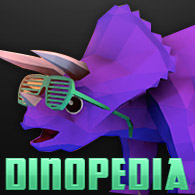Overview
Information about all Dinosaurs in game categorized by herbivores and carnivores.

Carnivores
All Carnivores in Parkasaurus are bipedal Theropod dinosaurs. (‘Bipedal’ means that they walked on two legs) The word ‘theropod’ comes from the Greek for ‘wild beast foot’. Theropods first appeared in the late Triassic period, and were present all the way up to the Cretaceous–Paleogene extinction event which brought the reign of the dinosaurs to an end.
Even though the Carnivores are solitary Dinosaurs, they still need a mate of the other gender in their Exhibit to be at 100% Social.
Class: Theropod
Tile: Mud
Biome: Swamp
Size: Medium
Exhibit Size: 700ft
Prefered Herd Size: Solitary + Dino of other Gender
_____________________________________________
Class: Theropod
Tile: Grass
Biome: Taiga
Size: Small
Exhibit Size: 500ft
Prefered Herd Size: Solitary + Dino of other Gender
_____________________________________________
Class: Theropod
Tile: Mud
Biome: Swamp
Size: Large
Exhibit Size: 700ft
Prefered Herd Size: Solitary + Dino of other Gender
_____________________________________________
Class: Theropod
Tile: Sand
Biome: Grassland
Size: Large
Exhibit Size: 1000ft
Prefered Herd Size: Solitary + Dino of other Gender
_____________________________________________
Class: Theropod
Tile: Sand
Biome: Desert
Size: Small
Exhibit Size: 500ft
Prefered Herd Size: Solitary + Dino of other Gender
_____________________________________________
Herbivores

Ankylosauria was a group of armored dinosaurs that lived throughout the Mesozoic era. They were large, powerful, four-legged animals. All were heavily armored, and some developed tail clubs which may have been used as defensive weapons against predators.
Ceratopsia means ‘horned faces’. This group of dinosaurs became common in the Cretaceous period and were found in North America, Europe and Asia. Like all Ornithischians, Ceratopsians were herbivorous. They had beak-like mouth parts. They ranged in size from 1 meter (3.3 ft.) to 9 meter (30 ft.) long, 9 tonne giants.
Ornithopods were a branch of Ornithischian dinosaurs that appeared in the mid Jurassic period and lived to the end of the Cretaceous. They had three-toed feet, beaks, and an advanced (for a dinosaur) chewing ability.
The Sauropods were a group of saurischian dinosaurs. Many sauropods grew to incredible sizes, and the group contains the biggest land animals ever to walk the earth. A typical sauropod had a large barrel-shaped body, a long neck, a small head, and a long, powerful tail. It stood on four tree-trunk like legs.
Stegosauria was a group of armored dinosaurs that had rows of bony plates running along their backs. Stegosaurus is the best-known Stegosaurian, but several other genera have been discovered.
Class: Ceratopsia
Tile: Sand
Biome: Savanna
Size: Medium
Exhibit Size: 700ft
Prefered Herd Size:
_____________________________________________
Class: Ankylosauria
Tile: Grass
Biome: Forest
Size: Medium
Exhibit Size: 700ft
Prefered Herd Size:
_____________________________________________
Class: Ankylosauria
Tile: Grass
Biome: Taiga
Size: Medium
Exhibit Size: 700ft
Prefered Herd Size:
_____________________________________________
Class: Sauropod
Tile: Sand
Biome: Savanna
Size: Large
Exhibit Size: 1000ft
Prefered Herd Size: 3
_____________________________________________
Class: Sauropod
Tile: Sand
Biome: Grassland
Size: Large
Exhibit Size: 1000ft
Prefered Herd Size:
_____________________________________________
Class: Ankylosauria
Tile: Sand
Biome: Grassland
Size: Medium
Exhibit Size: 700ft
Prefered Herd Size:
_____________________________________________
Class: Stegosauria
Tile: Mud
Biome: Alpine
Size: Medium
Exhibit Size: 500ft
Prefered Herd Size:
_____________________________________________
Class: Stegosauria
Tile: Mud
Biome: Tundra
Size: Medium
Exhibit Size: 700ft
Prefered Herd Size:
_____________________________________________
Class: Ornithopods
Tile: Grass
Biome: Taiga
Size: Medium
Exhibit Size: 700ft
Prefered Herd Size:
_____________________________________________
Class: Sauropod
Tile: Grass
Biome:[/b ]Rainforest
Size: Large
Exhibit Size: 1000ft
Prefered Herd Size:
_____________________________________________
Class: Ankylosauria
Tile: Grass
Biome: Forest
Size: Small
Exhibit Size: 700ft
Prefered Herd Size:
_____________________________________________
Class: Theropods
Tile: Mud
Biome: Tundra
Size: Medium
Exhibit Size: 700ft
Prefered Herd Size:
_____________________________________________
Class: Ornithopods
Tile: Mud
Biome: Tundra
Size: Medium
Exhibit Size: 700ft
Prefered Herd Size:
_____________________________________________
Class: Sauropod
Tile: Sand
Biome: Desert
Size: Large
Exhibit Size: 1000ft
Prefered Herd Size:
_____________________________________________
Class: Ornithopods
Tile: Mud
Biome: Swamp
Size: Medium
Exhibit Size: 700ft
Prefered Herd Size:
_____________________________________________
Class: Stegosauria
Tile: Grass
Biome: Rainforest
Size: Medium
Exhibit Size: 600ft
Prefered Herd Size: 3
_____________________________________________
Class: Ceratopsia
Tile: Mud
Biome: Alpine
Size: Medium
Exhibit Size: 700ft
Prefered Herd Size: 5
_____________________________________________
Class: Ceratopsia
Tile: Grass
Biome: Rainforest
Size: Medium
Exhibit Size: 600ft
Prefered Herd Size: 3
_____________________________________________
Thank you for looking at my guide! This was a lot of work, so I hope it helps some of you. 🙂
I am currently working on a document file so you can sort by categories such as tile, biome, size etc.
I used this[www.activewild.com] to describe the different types of dinosaurs.

























